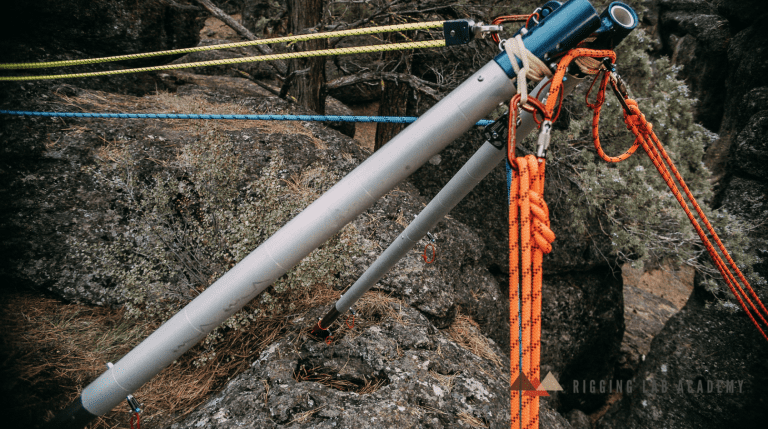In rope rescue, setting up reliable high-directional and anchor systems is essential for managing complex scenarios and ensuring safety. Knots play a crucial role here, not only in securing anchors but also in optimizing force multipliers that allow rescuers to operate efficiently and effectively. For fire service and SAR teams, choosing the right knot for these setups can mean the difference between a stable, secure system and one that may fail under pressure. In this second part of our series, we’ll explore how specific knots and force multipliers interact within high-directionals and anchor systems to maximize safety, adaptability, and performance.
Key Components of Knots and Force Multipliers in Anchor and High-Directional Systems
1. Creating Reliable Multi-Point Anchors
Multi-point anchor systems distribute loads across multiple anchor points, reducing stress on any single point. Knots like the figure-eight on a bight and bowline on a bight provide a secure, load-distributing connection essential for anchoring in variable terrain.
- Figure-Eight on a Bight: Offers high security and simplicity, ideal for creating multi-point anchors quickly and effectively.
- Bowline on a Bight: Strong and reliable, useful for adjustable, multi-point configurations in both natural and artificial anchors.
Why It Matters: Reliable anchor points prevent load shifts and ensure that forces are evenly managed, critical for maintaining system stability during rescues.
2. Force Multipliers in High-Directionals
High-directional systems like tripods, bipods, or monopods help clear obstacles and provide a direct path for loads. Using force multipliers, such as 3:1 or 5:1 mechanical advantage systems, enables rescuers to manage heavy loads with less effort, while knots like the alpine butterfly or double loop figure-eight support these setups by managing multi-directional forces.
- Alpine Butterfly: Excellent for mid-line applications in high-directional setups, distributing force evenly in multiple directions.
- Double Loop Figure-Eight: Strong and versatile, providing a solid base in high-directional systems and reducing stress on the main anchor.
Why It Matters: Effective force multipliers reduce rescuer fatigue and maximize lifting efficiency, enabling smoother, safer operations in complex rescues.
3. Secure Load Capture for Stability
Maintaining load control is vital in anchor systems, and knots like the prusik or kleimheist help with secure load capture and adjustability. These knots allow rescuers to control the load’s position, minimizing shifts and providing a backup in case of primary anchor slippage.
- Prusik Knot: Grips the rope securely while allowing for minor adjustments, ideal for load capture in dynamic systems.
- Klemheist Knot: Strong on both static and dynamic ropes, making it a reliable choice for adjustable load capture.
Why It Matters: These knots add security and redundancy, ensuring that loads remain stable throughout the operation.
4. Adaptability in Changing Anchor Scenarios
Rope rescue often demands flexibility, especially in unpredictable environments. Adjustable knots like the tensionless hitch and münter hitch allow for real-time adjustments, giving rescuers control over anchor points as conditions evolve.
- Tensionless Hitch: Provides excellent holding power without stressing the rope, commonly used in anchors with secure, rounded attachment points.
- Münter Hitch: Versatile for belaying and as an adaptable anchor knot in various high-directional setups.
Why It Matters: Adaptable knots allow rescuers to quickly respond to changing scenarios, ensuring the operation’s success and safety even in unpredictable environments.
Conclusion: Maximizing Efficiency with Knots in Anchor and High-Directional Systems
Knots and force multipliers play a foundational role in building strong, adaptable anchor and high-directional systems. By carefully selecting the right knots, rescue teams can ensure load stability, increase efficiency, and maintain flexibility across a wide range of rescue scenarios. This precision in knot choice and setup design ultimately supports safer, more effective rescues, empowering SAR and fire service teams to meet even the most challenging environments with confidence.
- Force Multipliers and The Fundamentals of Mechanics(Opens in a new browser tab)
- Rope Rescue Training for Veterans in Fire Service and SAR(Opens in a new browser tab)
- 4 Fundamentals of Force Multiplier Mechanics(Opens in a new browser tab)
- The Hierarchy of Rope Rescue Learning Pathway(Opens in a new browser tab)
- Knots for Force Multiplication in Rope Rescue(Opens in a new browser tab)
Stay tuned for Part 3, where we’ll address the critical safety considerations when selecting knots for force-multiplying systems.
Peace on your Days
Lance










